Voor het grootste deel van de opgetekende geschiedenis, mensen gebruikten rabarber alleen medicinaal. Inheems in China, men denkt dat Marco Polo rabarber heeft meegebracht van zijn reizen daar.
Rheum rhabarbarum werd pas in de late 18e eeuw als voedselbron gebruikt. De eerste geregistreerde vermelding is als een taartplant.
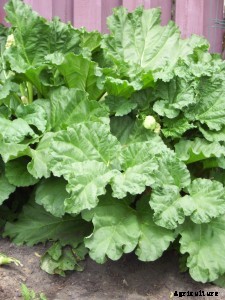
Rabarber werd op grote schaal geplant door pioniers in de Verenigde Staten, en veel van die oorspronkelijke aanplantingen overleven vandaag de dag in onze noordelijke steden.
Winterhard in USDA-zones 3 tot 8, rabarber wordt 2 tot 3 voet lang, afhankelijk van de variëteit. Het heeft temperaturen onder de 40 graden nodig om de winterrust te doorbreken en in het voorjaar met nieuwe groei te beginnen.
Plant rabarber in de volle zon in rijke tuingrond. Plaats de planten 3 tot 4 voet uit elkaar in rijen van 3 voet uit elkaar. De planten worden kleiner en minder productief als ze dichter bij elkaar worden geplant. Plaats de kroon ongeveer 2 inch onder het oppervlak van de grond - waterput.
Geef pas getransplanteerde rabarber het eerste jaar in uw tuin water. Daarna is het redelijk goed bestand tegen droogte.
Oogst geen rabarber in het eerste jaar dat u hem plant. Zoals asperges, het moet het eerste jaar al zijn energie steken in het opbouwen van een sterk wortelstelsel.
Oogst het tweede jaar spaarzaam. Oogst alleen stengels die minstens 2,5 cm dik zijn. Tijdens zijn derde jaar, oogst ongeveer een maand in het voorjaar. Daarna, oogst stengels als ze rijpen voor het hele rabarberseizoen, die ongeveer zes weken loopt vanaf het moment dat de eerste stengels in het vroege voorjaar klaar zijn om te oogsten.
Snijd de stengels af bij de grondlijn of pak een stengel bij het grondoppervlak en draai deze weg van de kruin.
Rabarber is de taartplant; het wordt voornamelijk gebruikt als fruit in taarten, chips, compote, en jam. Tot een smeuïge saus gemaakt, het is ook een goede metgezel voor zeevruchten.
Een van mijn vroegste jeugdherinneringen is het plukken van een stengel rabarber vers uit de tuin, onderdompelen in suiker, en rauw eten. Natuurlijk, dat was voordat wetenschappers ontdekten dat suiker slecht voor je was.
Ik beoefen selectief geheugenverlies als het gaat om dergelijke ontdekkingen.
Een van mijn vroegste herinneringen is het plukken van verse erwten in de tuin, haal ze dan uit de peul en eet ze rauw op.
Dat waren de traditionele Engelse doperwtjes die mijn moeder kweekte. Ik heb nog nooit Engelse erwten gekweekt; Ik kies ervoor om de ruimte te gebruiken om Oriental Snow Peas of Sugar Snap Peas te kweken.
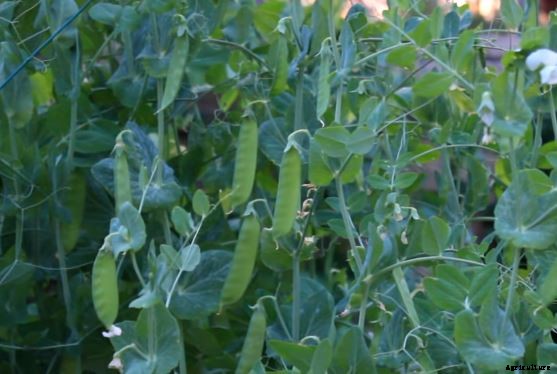
Deze afgelopen winter, terwijl ik mijn zadenverzameling organiseer en opruim, Ik kwam twee pakken erwten tegen - een van Snow en Sugar Snap. Ik had op de verpakking geschreven dat ik ze in 2002 uit mijn tuin had gehaald, dat was het laatste jaar dat ik een grote moestuin had, wegens blessure en ziekte.
Als zuinige tuinier, Ik wilde ze niet weggooien. Ik heb ze in een spruitje gedaan die is ontworpen om alfalfa of andere kleine spruiten voor in de keuken te kweken. Zoals je kunt zien op de bovenstaande foto, binnen een paar dagen, ze waren ontkiemd.
Slechts tien Peultjeszaadjes ontsproten, en op één na hebben ze allemaal grond in de tuin gebroken. Wat betreft de Sugar Snap erwten, slechts acht ontsproten en tot nu toe, een of twee hebben gebroken grond.
Pisum sativum var. macrocarpon, of Peultjes, is gevonden in Chinese en Egyptische archeologische vindplaatsen uit 12, 000 jaar geleden. Er wordt gedacht dat de naam is afgeleid van de witachtige tint die door de peulen in zonlicht wordt weerkaatst of dat ze vaak doorgroeien tijdens sneeuwval in het late seizoen.
Erwten zijn niet kieskeurig over in wat voor grond ze groeien, zolang het maar goed gedraineerd is; erwtenzaden zullen rotten als ze worden geplant in grond die niet goed afvloeit.
Plant erwten in het vroege voorjaar zodra u de grond kunt bewerken. Plant ongeveer twee centimeter uit elkaar en ongeveer een centimeter diep. Wanneer ongeveer vijf centimeter hoog, dun om drie tot vier centimeter uit elkaar te staan.
Zorg voor een trellis waar je Snow- of Sugar Snap-erwten op kunnen klimmen. Ze worden veel groter dan hun Engelse erwt-tegenhanger.
Erwten zijn een peulvrucht, en zoals alle peulvruchten, ze fixeren stikstof in de bodem. Wat betekent dit voor uw tuin? De planten halen stikstof uit de lucht (als magie) en geven het via hun wortels af, waardoor het in de grond wordt "vastgezet". Dit is vooral gunstig voor gewassen die veel stikstof nodig hebben, zoals groenten of maïs.
Erwten stoppen met produceren als het warme zomerweer aanbreekt, dus ze zijn een perfect gewas voor opeenvolgende aanplant. In mijn tuin dit jaar Ik zal maïs planten vlak naast het hek waar de erwten zullen klimmen; ze zullen uit elkaar blijven omdat de maïs niet groot genoeg is geworden om de erwten te verdringen voordat de erwten klaar zijn met produceren.
Een belangrijk ding om te onthouden over erwten:nadat ze zijn gestopt met produceren als het warm weer is, snij de wijnstokken af op grondniveau en laat de wortels in de grond. Ze zullen blijven rotten en stikstof aan de grond toevoegen.
Ik weet zeker dat ik dit jaar maar een paar maaltijden krijg van mijn tiental erwtenranken, maar ze zullen ook zaden produceren om volgend jaar te planten.
Uit mijn onderzoek blijkt dat de nieuwe groei aan de toppen van erwtenranken vaak wordt gesneden en gewokt als een groente in oosterse gerechten. Dit ga ik dit jaar zeker als nieuwe lentegroente proberen.
Vinca minor is een van de zeldzame planten waarvan de Latijnse naam als algemene naam wordt gebruikt. Ook wel kruipende mirte of maagdenpalm genoemd, vinca is een groenblijvende meerjarige bodembedekker. Hij bloeit in het voorjaar met charmante paarse bloemen die de plant bedekken.
Vinca is inheems in Noord- en Midden-Europa en is winterhard in USDA-zones 3 tot 9. In sommige gebieden is het kan als invasief worden beschouwd.
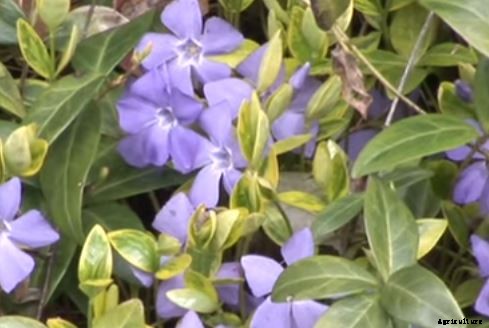
Vinca staat het liefst in de volle schaduw tot halfzon. De bladeren zullen vervagen, en de plant zal flauw zijn als hij in de volle zon wordt gekweekt.
Geplant op een heuvel, vinca helpt erosie te voorkomen. Zijn wortels zullen zich vastklampen aan de grond, en het zal bijna alle onkruid verdringen. Het verspreidt zich en geeft je paarse bloemen in de lente en groenblijvende bladeren voor de rest van het jaar.
Vinca zal zelfs groeien en gedijen onder een groenblijvende boom.
Space vinca transplanteert ongeveer 18 centimeter uit elkaar in rijke grond in gedeeltelijke tot volledige schaduw. Geef het eerste jaar na het planten goed water, en daarna, vinca zorgt wel voor zichzelf.
Verwacht dat je vinca-bodembedekker zal groeien en zich zal verspreiden in een mat van ongeveer 2 tot 3 voet breed en 6 tot 12 inch hoog.
Folklore vertelt ons dat vinca verondersteld wordt liefde te inspireren en vroege herinneringen of herinneringen aan te duiden.
Welke prettige herinneringen roept vinca bij jou op?
Een bruidskransstruik, of spirea, is een voorjaarsbloeiende struik die in steden over de hele wereld wordt geplant.
Ze groeien goed in bijna elke grond en, eenmaal opgericht, tolereren droogte en verwaarlozing.
Hun delicate witte bloemen op sierlijke takken bloeien elk voorjaar betrouwbaar.
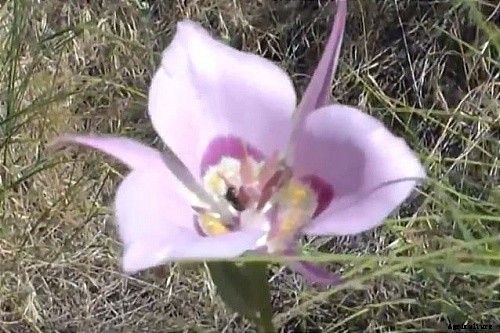
Plant voorjaarsbloeiende bruidskransen in halfschaduw. Snoei lichtjes direct nadat de bloemen zijn uitgebloeid. Ze bloeien volgend jaar op hout dat dit jaar groeit dus spaarzaam snoeien.
De klassieke bruidskransstruik is Spirea Vanhoutte. Dit ras wordt al minstens honderd jaar op grote schaal aangeplant in de Verenigde Staten. Het wordt 6 tot 8 voet lang en produceert eind mei en begin juni puur witte bloemen.
De bloemen zien eruit als mini-boeketten. Eeuwenlang werden ze om zich heen gedraaid om slingers of boeketten te maken voor bruiloften. Zijn Latijnse naam, Spirea, komt van een oud Grieks woord dat gedraaid of spiraalvormig betekent.
De bruidskrans op de foto groeit in de tuin van een verlaten flatgebouw. Het staat gedeeltelijk in de schaduw van een esdoorn, en het gras in de tuin staat kniehoog. Nog, het bloeit alsof het wordt verzorgd door een gewetensvolle tuinman.
Elke tuin heeft een paar planten nodig die weinig onderhoud vergen.
Morieljes zijn de ongrijpbare wilde paddenstoel die in de lente verschijnt in de bossen van Maine, zuiden naar de noordelijke gebieden van het diepe zuiden, west naar het noorden van Texas en Oklahoma, en noordwaarts naar Minnesota met een paar buitenposten in de Dakota's.
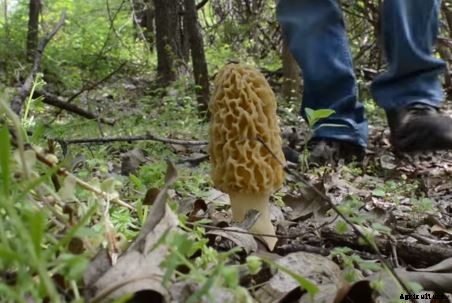
Als je nog nooit een morille hebt geproefd, het is moeilijk te begrijpen welke serieuze obsessie morel-jagers hebben met het vinden van deze wilde delicatessen.
Vorige lente, Ik vond er een in mijn tuin midden in de stad. Deze lente, mijn zoon ontwikkelde een obsessie om ze te vinden. Ik heb zelden zo'n doelgerichtheid en vasthoudendheid gezien. We hebben het grootste deel van een week gejaagd en slechts drie kleintjes gevonden.
Gisteren nam hij zijn zoon mee en ging langs de oevers van de Mississippi bij St. Paul en vond een dozijn bakkers. Scoren!
Hij nam de bovenstaande foto in situ van een paar morieljes die ze vonden.
Mijn zoon maakte pasta met saus uit een pot voor het avondeten. Hij sloop een in blokjes gesneden morille in de saus, en zijn zoon sprak het heerlijk uit. Pas toen kreeg het kind te horen dat de saus morieljes bevatte.
Zoon van zoon heeft inmiddels besloten dat hij van morieljes houdt.
We hebben besloten om wat morieljes te drogen en ze te gebruiken om een bijgerecht of voorgerecht te maken om met Kerstmis te serveren. We hebben ook besloten dat we daar een jaarlijkse traditie van willen maken.
En ik heb vernomen dat de jacht op morieljes dit jaar nog niet voorbij is.
Dat zijn mijn jongens.
Lelietje-van-dalen is een van de vele zoetgeurende, voorjaarsbloeiende bloemen. Zijn Latijnse naam, Convallaria majalis, is afgeleid van het Latijnse Corvallis, "vallei, ” en majalis, "Meibloeiend." Het is de officiële geboortebloem voor mei.

Ik kwam toevallig een stukje van de minder voorkomende roze (Convallaria majalis Rosea) tegen en stopte om hun foto te maken. De tuinman zag me en stond erop me wat voor mijn tuin te geven. Ik heb ze in een bed geplant dat een deel van de dag schaduw krijgt.
Lelietje-van-dalen geven de voorkeur aan een schaduwrijke locatie die slechts een paar uur zon per dag krijgt. Ze houden van vochtige grond, maar houden niet van stilstaand water. Zorg ervoor dat het gebied waarin u ze plant goed gedraineerd is, en geen water zit daarna een regenbui.
Kweek lelietje-van-dalen uit "pitten, Dit zijn kleine bolletjes die zich samen met de wortels onder de grond vormen. Ze verspreiden zich gemakkelijk en zullen binnen een paar jaar een gebied vullen.
Plant de pitten 4 tot 5 inch uit elkaar in vochtige, rijke bodem. Bemesten met een korrelige meststof in de lente en mulch met bladvorm in de herfst. Behalve dat, je lelietje-van-dalen zullen vrijwel voor zichzelf zorgen.
Verdeel ze om de vijf jaar, zodat ze elkaar niet verstikken. Doe dit in het vroege najaar. Graaf het hele bed op. Snijd de wortels uit elkaar zodat er maar één pitje per plant is. Herplant 4 tot 5 inch uit elkaar in alle richtingen en geef goed water. In de late herfst, mulch het bed met bladvorm of herfstbladeren. Verwijder de mulch in het vroege voorjaar.
Pluk boeketten nadat de eerste paar "klokjes" zijn geopend, zoals die op de foto. Op die manier, de knoppen aan de bovenkant van de bloemstengel zullen sneller opengaan in huis.
Een klein boeket lelietje-van-dalen zal een hele kamer parfumeren. Hun charmante, petite size bloesems zijn perfect voor kleine vazen op nachtkastjes of de badkamerijdelheid.
Als je een grote pleister hebt en genoeg geduld hebt, je kunt ze ook drogen om in potpourri te gebruiken. De droogbloemen zullen jarenlang hun geur behouden.
Lees ook:Snij- of dode lelies als ze uitgebloeid zijn.
Vrijgezellenknoppen zijn populair als tuinplant en snijbloem. Oorspronkelijk gevonden in het wild groeiend in de graanvelden van Europa, Centaurea cyanus groeit nu in het wild over het hele noordelijk halfrond.
Hun oorspronkelijke kleur is blauw (zoals aangegeven door de tweede naam, cyaan), maar ze zijn nu verkrijgbaar in donker kastanjebruin, rood, roze, en wit. Bachelor-knoppen worden ook vaak "korenbloemen" of "bluebottles" genoemd.
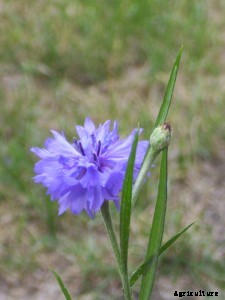
Ze groeien in alle grondsoorten, maar geven de voorkeur aan volle zon. Ze worden meestal uit zaad gekweekt en zijn niet algemeen verkrijgbaar als startertransplantaties. Korenbloemen zaaien zichzelf vrij gemakkelijk opnieuw. Aan hun lot overgelaten, ze zullen jaar na jaar in hetzelfde algemene gebied verschijnen.
De zaadpakketten raden aan om ze ongeveer twee weken voor uw gemiddelde laatste voorjaarsvorst te zaaien. In mijn tuin, de zaden die vorig jaar zijn gevallen, beginnen minstens een maand voor onze gemiddelde laatste voorjaarsvorst op te komen.
In elk geval, plant de zaden ongeveer 1/4 inch diep en houd vochtig tot ontkieming optreedt, in ongeveer 7 tot 14 dagen. Dun tot 8 tot 12 inch uit elkaar als ze ongeveer 3 inch hoog zijn.
Hun bloesems zijn eetbaar en smaken kruidnagelachtig met een beetje zoet en pittig erbij. Door hun felblauwe kleur zijn ze ideaal als decoratie voor zomerse taarten. Gooi ze in koude zomersoepen en salades.
Gemaakt tot een afkooksel, korenbloembloesems zijn effectief bij de behandeling van ooginfecties, zoals bindvliesontsteking. Een afkooksel wordt ook gebruikt als wasmiddel om vermoeide ogen te doen herleven. In de kruidengeneeskunde, korenbloemen staan bekend om hun helende eigenschappen.
Korenbloemen worden ook gebruikt als ingrediënt in thee, waaronder de populaire Lady Grey blend. Hun blauwe bloemen werden gebruikt als voedselkleuring en pigment voor aquarelverf. Verschillende naties en doelen hebben het geadopteerd als een symbool van hun collectieve trots.
In een tijd dat bloemen als symbolen werden gebruikt, beschikbare mannen zouden ze als corsages dragen. Dit is hoogstwaarschijnlijk de oorsprong van hun meest populaire algemene naam. "bachelorknoppen."
Tropische hibiscusplanten zijn elk voorjaar verkrijgbaar bij tuincentra. Als de zomer voorbij is, deze tropische variëteit, Hibiscus rosa-Sinensis, belandt in de prullenbak of composthoop; ze zijn gewoon niet winterhard genoeg om de winter ten noorden van de tropen te overleven. En niet veel mensen hebben de juiste omstandigheden in huis om de planten binnenshuis te overwinteren, of.
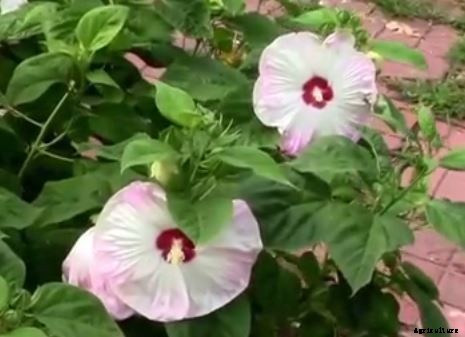
Wist je dat er een winterharde hibiscus is? De Latijnse naam is Hibiscus moscheutos, en het wordt gewoonlijk "kaasjeskruid" genoemd. Zij zijn, natuurlijk, verwant aan de tropische hibiscus maar zijn inheems in Noord-Amerika. Ze hebben de grootste bloemen van alle hibiscus - sommige zijn 30 cm in doorsnee.
Hibiscus moscheutos zijn betrouwbaar winterhard tot USDA Zone 4, en met extra winterbescherming, Zone 3. Hoewel ze houtachtige stengels hebben, ze worden als vaste planten beschouwd omdat ze in de winter volledig afsterven tot op de grond.
Winterhibiscus is een van de laatste planten die in het voorjaar begint te groeien. Vaak is het eind mei of begin juni voordat de stengels gaan groeien; geef ze niet te vroeg op. Ze bloeien in juli en blijven bloeien tot het vriest.
Knijp de groeipunten af als de takken ongeveer een voet lang zijn. Dit zal de plant aanmoedigen om te vertakken en nog meer bloemen te produceren. Het is niet ongebruikelijk dat een winterharde kaasjeskruidhibiscus meer dan honderd bloemen per seizoen produceert.
Plant winterharde hibiscus in de volle zon in een bodem die veel vocht vasthoudt. Dit is een plant die goed groeit in zware, vochtige grond. Blijf het hele groeiseizoen goed water geven, en je winterharde hibiscus zal zelfs in het heetste deel van de zomer bloemen blijven produceren.
Wanneer de plant door vorst wordt gedood, snijd de takken een paar centimeter boven de grond af en mulch goed voordat consistent vriesweer arriveert.
Hibiscus moscheutos groeit zelfs in moeras- of moerasachtige omstandigheden. Ze zijn uitstekende kandidaten voor laaggelegen gebieden met een slechte afwatering of waterrijke tuinen.
Winterhibiscus groeit snel tot een hoogte van ongeveer twee voet. Ze vormen uitstekende zomerhagen, snel groeiend om een buiten "kamer" of speciale tuin te definiëren.
En het zijn vaste planten, je hoeft ze dus niet elk jaar te planten.
Ginkgobomen zijn levende fossielen die niet gerelateerd zijn aan een levende plant. Fossiele gegevens van verwante soorten eindigen overal na het Plioceen, behalve in een klein deel van Centraal-China.
De ginkgo-boom leeft voor honderden, soms duizenden jaren. Er groeien exemplaren in de buurt van kloosters in China waarvan wordt aangenomen dat het er 1 zijn. 500 jaar oud. Van andere exemplaren in China is bekend dat ze ouder zijn dan 3, 000 jaar oud.
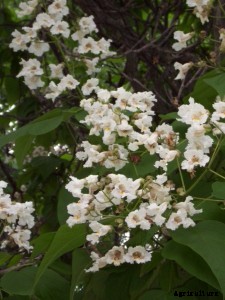
Vier ginkgo Biloba-bomen hebben de atoombom in Hiroshima overleefd en leven nu nog in die stad.
Ze behoren tot de zwaarste, meest veerkrachtige bomen die vandaag de dag leven en worden op grote schaal geplant in stedelijke gebieden in Noord-Amerika. Weinig plagen of ziekten storen hen, en ze kunnen meer dan honderd voet lang worden.
Hun enige nadeel is een stinkende geur die wordt geassocieerd met hun zaaddozen, die naar ranzige boter of zelfs uitwerpselen kan ruiken.
De ginkgo-boom is tweehuizig, wat betekent dat het zowel mannelijke als vrouwelijke planten produceert. Omdat de vrouwtjes de stinkende zaaddozen produceren, stekken van mannelijke bomen worden geënt op zaailingen en worden vaker geplant dan vrouwtjes. Ze bloeien nog steeds, maar produceren geen zaden.
De ginkgoboom kleurt in de herfst felgeel. Ze hebben een ongewone kwaliteit doordat hun bladeren geel worden en er binnen een korte periode van 10 tot 15 dagen afvallen.
Ginkgo bomen groeien in de volle zon tot halfschaduw en zullen goed groeien in vrijwel elke grondsoort, zolang het maar voldoende wordt afgevoerd. Hun zuilvormige vorm en rechtopstaande groeiwijze maken ze natuurlijk als schaduwbomen die langs stadsstraten in USDA-zones 3 tot 8 zijn geplant.
Ze bloeien eind juni hier in Zone 4, en hun bloei duurt maar een paar dagen. Bovenstaande foto is midden in de zomer gemaakt, net toen de bloemen begonnen te verwelken.
Black-eyed Susans zijn een Amerikaanse wilde bloem die inheems is in de westelijke prairies. Ze zijn een van de eerste planten die gaan groeien op vrijgemaakt land.
Rudbeckia hirta is de Latijnse naam voor hen, hoewel ze vaak worden verward met andere soorten.
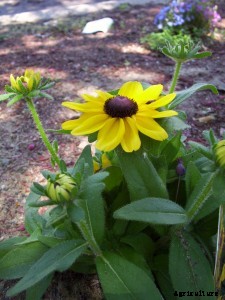
Een ding dat ze anders maakt dan de meeste andere wilde bloemen, is dat ze geen geur hebben. Er is ook heel weinig geschiedenis of folklore geassocieerd met Susans met zwarte ogen, hoogstwaarschijnlijk omdat er geen medicinaal gebruik bekend is.
Black-eyed Susans groeien het beste in de volle zon, maar ze hebben geen super vruchtbare grond nodig om goed te groeien. Als de grond te rijk is, bloemproductie zal eronder lijden.
Je kunt zwartogige Susans van zaad binnen of door direct in de tuin te zaaien. Plant zaden buiten in het vroege voorjaar zodra de temperaturen betrouwbaar boven de 60 graden zijn. Wanneer zaailingen ongeveer vijf centimeter hoog zijn, dun, dus ze staan ongeveer 1 1/2 voet uit elkaar. Ze zullen het eerste jaar bloeien als ze vroeg genoeg worden gestart.
In het voorjaar zijn ze ook als perkplant verkrijgbaar. Verwijder eventuele bloemen op de transplantaties. Dit zal de planten aanmoedigen om sterke wortelstelsels te ontwikkelen en je later in de zomer belonen met meer bloemen.
Plaats ze ongeveer 1 1/2 voet uit elkaar en geef water totdat ze zich vestigen. Zodra ze actief in uw tuin groeien, Black-eyed Susans groeien vrij goed zonder extra water.
Verdeel ze ongeveer om de vier of vijf jaar, of als je merkt dat de bloemen kleiner worden. dood, of het verwijderen van de uitgebloeide bloemen, zal het aantal bloemen en het bloeiseizoen verhogen.
Black-eyed Susans is een onderhoudsarme vaste plant die gemakkelijk bestand is tegen droogte en verwaarlozing.
rozen, die grote hoeveelheden water en aandachtige zorg nodig hebben, groeien in een verlaten, omheinde parkeerplaats.
Wat voor mij verbazingwekkend is, is dat we net de op twee na droogste lente in ons gebied hebben gehad sinds het bijhouden van het weer meer dan honderd jaar geleden begon.
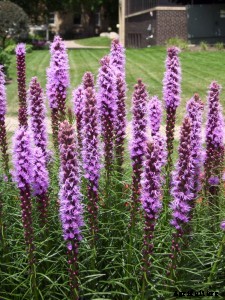
Laatste val, een fastfoodrestaurant in de buurt sloot op mysterieuze wijze midden op de werkdag. Ze zetten het adres van hun dichtstbijzijnde restaurant op de tent, de ramen dichtgetimmerd, en zet een gaashekwerk rond het hele pand.
Bijna negen maanden later, Ik kon het niet helpen, maar zag de rozen groeien op de voorheen aangelegde parkeerplaats. Ik nam de foto hierboven door het hek met kettingschakels dat was opgericht om indringers buiten te houden.
Blijkbaar, de landschapsstof in het rozenbed houdt voldoende onkruid tegen om de roos te laten groeien.
Het doet denken aan de vele rozenverenigingen die actief oude rozenrassen zoeken en redden. Veel oude rozen groeien in het wild zonder hulp van tuinders. Deze rozen staan op braakliggende terreinen, verlaten boerderijen, en oude begraafplaatsen. Document van de erfgoedverenigingen voor het behoud van rozen, oude rozen stekken en vermeerderen zodat ze niet voor ons verloren gaan.
Het doel van de meeste van deze verenigingen is het verzamelen van zogenaamde "oude" rozen - die zijn ontwikkeld voordat de genen van Chinese rozen in de genenpool werden gefokt. Hoewel dit het primaire doel kan zijn van heirloom rozenredders, Ik wed dat veel obscure 'moderne' rozenvariëteiten hun weg hebben gevonden naar de bescherming en teelt van deze organisaties.
Een rozenliefhebber zal niet weigeren een mooie, onbekende rozenvariëteit simpelweg omdat het niet oud genoeg is.
Ten slotte, "een roos is een roos."
Ageratum, ook wel "floss bloemen, ” zijn inheems in Midden-Amerika en Mexico, hoewel vier soorten zijn geïdentificeerd als inheems in de Verenigde Staten.
De meest geteelde variëteit is Ageratum houstonianum. Ageratum is van het Griekse "a geras, ” wat betekent “niet-verouderend, ” waarschijnlijk verwijzend naar de levensduur van de bloemen.
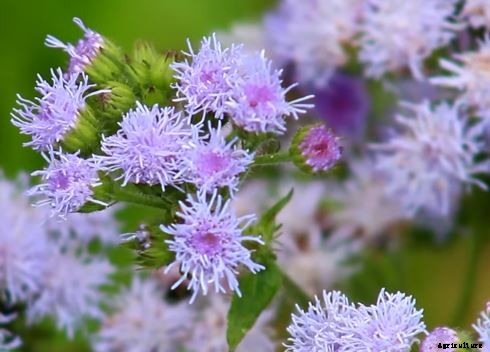
De bloemen zijn pluizig en verkrijgbaar in lila, roze of wit, en het immer populaire lavendelblauw. Ze verspreiden zich in samengestelde bloemschermen, waardoor ze een pluizig uiterlijk krijgen, een soort van afgeplatte pompons.
Omdat de meeste soorten minder dan een voet hoog worden, Ageratum is populair als randplant of verscholen in containers of hangende manden. Ze bloeien uitbundig van juni tot ze door de vorst worden gedood. Hoewel ze de voorkeur geven aan de volle zon, ze zijn het gelukkigst met een beetje schaduw tijdens de heetste delen van de zomer.
Je kunt ze direct in de tuin zaaien, maar ze zullen pas na midzomer bloeien. Voor eerdere bloei, zet ze binnen 6 tot 8 weken voor je laatste voorjaarsvorst binnen. De zaden hebben licht nodig om te ontkiemen, dus strooi ze op het startmedium van de zaden en druk ze lichtjes aan met je hand.
Geef water van onderaf door de starterpotten in een grotere bak te plaatsen die ongeveer 2,5 cm water bevat. Haal de potten uit het water als het oppervlak van het startmedium vochtig lijkt. Dit voorkomt dat de zaden in de diepten van de grond worden gespoeld. Laat het overtollige water weglopen, en laat de starterpotten niet in stilstaand water staan. Onthoud:de zaden hebben licht nodig om te ontkiemen, dus ze moeten op of in de buurt van het grondoppervlak blijven.
Flossbloemen hebben warmte nodig om te ontkiemen, zet de starterpotten dus op een warme plek, zoals op de koelkast. De zaden zullen rotten als de bodemtemperatuur lager is dan 75°, en ze zullen nog gelukkiger zijn op 80°. Als u moeite heeft met het verstrekken van deze temperaturen, zet de startpotten op een startmat voor zaden of zelfs een verwarmingskussen op de laagste temperatuur en bedekt met een opgevouwen handdoek.
Zodra de zaden zijn ontkiemd (in ongeveer 7 dagen) en twee sets bladeren hebben, je kunt ze kweken bij temperaturen zo laag als 60°. Paradoxaal genoeg, ze hebben hoge temperaturen nodig om te ontkiemen, maar geven de voorkeur aan koelere temperaturen wanneer ze actief groeien. Ga figuur.
Na uitharden, plant buiten een week of zo voor uw gemiddelde laatste voorjaarsvorst. Echter, ze zijn ijskoud, planten die voldoende zijn geacclimatiseerd aan de buitenomstandigheden en al een week of zo in de grond groeien, vertonen enige tolerantie voor lichte vorst.
Verwijder de uitgebloeide bloemen door ze uit te knippen om te voorkomen dat er zaden ontstaan. Ageratum kan onkruid worden als het buiten hun natuurlijke verspreidingsgebied wordt gekweekt.
Sommige soorten worden medicinaal gebruikt, hoewel er weinig gegevens zijn over specifieke toepassingen of hun medicinale effectiviteit. Van Ageratum houstonianum is bekend dat het bij inname leverschade of tumoren veroorzaakt.
Plant flossbloemen in de buurt van goudsbloemen of andere gele bloemen voor een verbluffend, oogverblindende weergave.
Liatris is inheems in het oosten van de Verenigde Staten en in het westen van de Great Plains. Ze zijn geëxporteerd naar Europa en zijn uitgegroeid tot een van de meest populaire bloeiende planten die in boeketten worden gekweekt.
Een inheemse Amerikaanse wilde bloem wordt legitiem in de wereld van bloemisten en snijbloemen.

Liatris spicata is de Latijnse naam; het wordt ook vaak Liatris genoemd, homoveer, en stralende ster.
Liatris houdt van volle zon en zal gemiddeld groeien, goed doorlatende grond. Ze zijn zeer droogtetolerant, en hun wortels moeten vrij van stilstaand water groeien, vooral tijdens de winter. Te veel water op elk moment van het jaar zal ervoor zorgen dat hun wortels gaan rotten. Ze tolereren lichte schaduw maar zullen minder bloemen produceren.
Ze zijn gemakkelijk te starten vanuit zaad of door worteldeling. Afhankelijk van de variëteit, verdeel planten om de 3 tot 4 jaar en herplant de verdeelde knollen 9 tot 18 inch uit elkaar.
Zaden hebben een periode van koud weer nodig voordat ze zullen ontkiemen. Verspreid ze in de late herfst in uw tuin, en velen zullen de volgende lente ontkiemen. Je kunt hun zaden ook mengen met vochtig zand in een plastic zak. Zet de zak een paar maanden in de koelkast, plant dan in een zaad-startmengsel. Bewaar ze op ongeveer 70°-75° totdat ze ontkiemen (in ongeveer 10 dagen tot 2 weken). Daarna, je kunt ze kweken bij temperaturen in de hogere jaren 60.
Plant ze buiten in de tuin. Het gevaar voor vorst is immers voorbij. Liatris die vanuit zaad zijn gestart, bloeien pas in hun tweede jaar.
Ze hebben een ongewone bloeiwijze, in plaats van de bloemen die van onder naar boven opengaan, zoals de meeste bloemen die in trossen op stekelige stengels worden geboren, Liatris bloemen openen van boven naar beneden. Je kunt de bovenkant van een van de spikes afsnijden, en de bloemen verderop in de stengel zullen zich in de tuin blijven openen.
Liatris geeft je weinig problemen, zolang ze maar ver genoeg uit elkaar staan en de grond waarin ze groeien goed gedraineerd is. Als ze te dicht bij elkaar groeien, ze zijn gevoelig voor echte meeldauw. Verwijder aangetaste bladeren bij het eerste teken ervan; u kunt mogelijk een volledige infectie afweren.
Je zult zien dat er een groot aantal vlinders naar Liatris stromen. Ze staan bekend als planten die geschikt zijn voor een vlindertuin. vogels, vooral goudvinken, eet hun gerijpte zaden in de late zomer en vroege herfst.
Zoete alyssum is een ideale plant om bloementuinen af te randen of voor de randen van containers. Het wordt slechts een paar centimeter hoog en valt uiteindelijk om op een aantrekkelijke manier die velen charmant vinden.
Alyssum is een van de meest populaire kuipplanten vanwege zijn kleine groeiwijze. Laat u echter niet misleiden, het kan klein zijn, maar het trekt de aandacht.
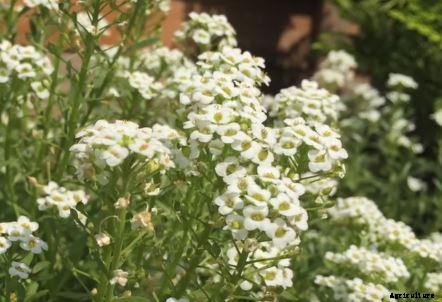
de kleine, sierlijke bloemen bloeien continu vanaf de late lente tot een harde, dodelijke vorst het groeiseizoen effectief beëindigt.
Een lid van de kruisbloemige familie, zoet alyssum is botanisch geclassificeerd als Alyssum Maritima. Hoewel de voornaam er bijna altijd naar verwijst, het wordt soms "candytuft" genoemd.
Sweet alyssum is ook verkrijgbaar in pastelroze, lavendel, en paarse variëteiten. Een meerjarige variëteit produceert gelijkvormige gele bloemen.
Alyssum is natuurlijk voor luie tuiniers omdat het zichzelf zaait en halverwege de lente begint op te komen nadat de grond een beetje is opgewarmd. Als je eerder wilt bloeien, je kunt het ongeveer 4 tot 6 weken voor je laatste voorjaarsvorst binnenshuis met zaad beginnen.
Plant candytuft in de volle zon tot halfschaduw. In de warmere delen van de provincie, ze zullen halfschaduw waarderen, vooral tijdens de heetste zomermaanden. Planten die in gedeeltelijke tot grotendeels schaduw worden gekweekt, zullen minder krachtig groeien, maar zullen nog steeds een respectabele hoeveelheid bloemen produceren.
Geef ze regelmatig voeding om de bloemen te laten komen. Het is het beste om een vloeibare meststof of een thee van mest of compost te gebruiken. Zo voorkom je dat je de wortels van de plant beschadigt als je kweekt met korrelmest.
Alyssum begint er langbenig uit te zien naarmate ze groter worden en zal ongeveer halverwege het groeiseizoen baat hebben bij een goede snoei. Snijd de planten ongeveer de helft terug. Dit zal hen dwingen om te vertakken, en ze zullen nog veel meer bloemen produceren.
Het "zoete" in zoet alyssum komt van zijn subtiele geur. Net als andere subtiel zoetgeurende bloemen, het kan het beste worden geplant in de buurt van een ingang of terras waar iedereen van de heerlijke geur kan genieten. Zoals zoveel andere witte bloemen, het lijkt 's nachts meer geur af te geven.
Alyssum is een goede plant om in een maanlichttuin op te nemen ... maar dat is een andere post.
Paarse zonnehoed werd op grote schaal gebruikt door indianen om een verscheidenheid aan kwalen te behandelen. De botanische naam Echinacea purpurea komt van het Griekse echinos (hun woord voor egel), die verwijst naar het stekelige centrum van de bloem, en de Latijnse purpura, wat verwijst naar de paarsrode kleur.
Echinacea purpurea zijn vaste planten die groeien tot een hoogte van 2 tot 3 voet. They are often propagated by root division but are just as easily started from seed. Plants started from seed will bloom in October the first year and in July thereafter.
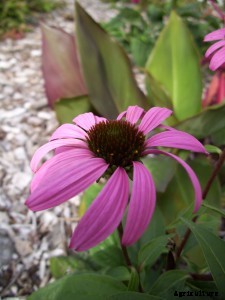
Plant echinacea in full sun to shade in fertile loamy soil, although they will grow in clay or sandy soil. They are relatively drought-resistant but will show signs of wilting if the soil becomes excessively dry.
Divide the plants by digging up and dividing the roots every 4 to 5 years.
Purple coneflowers attract a variety of different bees and butterflies. Goldfinches eat the mature seeds in early fall. Their pointy seed heads add a unique component to dried flower arrangements.
Native Americans treated everything from toothaches to colds to minor cuts, wounds, and burns. Rather than using the plant’s parts to make a healing tea, they chewed the roots, or the foliage was mashed up and made into a salve.
European settlers adopted the plant for medicinal purposes until it fell out of use in the 1930s. It has been re-discovered in recent years primarily as a cold and flu preventative, although its medicinal uses are far more extensive than that.
The juice of the roots was mixed with water and sprinkled on hot coals in traditional Native American “sweat lodges” for purification purposes. It is regarded today as an antibiotic and blood purifier that builds up the immune system. Some claim it provides immunity to a host of non-specific diseases.
Scientific research has not yet determined the exact compounds in purple coneflower that give it medicinal properties. Nog altijd, a long history of use in traditional folk medicine suggests that it is, in feite, effective as a medicinal herb.
Petunias are among the most popular flowers in urban home gardens, landscaped parks, and public areas everywhere. They are also featured in containers and hanging baskets in cities all over the country.
Petunias are also one of the newest garden flowers. They are native to South America and didn’t become well-known until the last part of the 19th century. It wasn’t until the 20th century that plant breeders began to select and breed them into the modern varieties we know today.
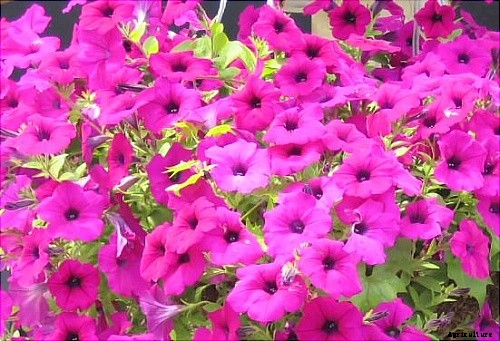
Petunias are collectively referred to today as Petunia x hybrida. They are thought to be a cross between Petunia axillaris (the night-scented white petunia) and Petunia integrifolia (a small violet-flowered variety). Petunias belong to the Solanaceae family, along with tomatoes, aardappelen, and tobacco.
New classes of varieties of petunias have continued to be released, with the latest big addition in the early 1990s. There are now four main classes of petunias, suited to various uses, from garden specimens to ground covers to those with pendulous habits that cascade over the edges of window boxes or hanging baskets.
These classes of petunias include groundcover or “spreading” petunias, Grandiflora petunias, multiflora petunias, and multiflora petunias. Here’s a short description of each:
Grandiflora petunias. These produce large flowers that are at least three inches across and sometimes larger. They come in single- or ruffled double-flowered varieties. Most are upright plants that develop into large, foot-high mounds of flowers.
Groundcover or “spreading” petunias. This variety grows to only about 6 inches high but spread rapidly to cover an extensive area in a single growing season. They will quickly cover several square feet and are ideal for use in hillside gardens where quick coverage is important. These spreading varieties are stunningly planted in hanging baskets or window boxes because they cascade 2 to 3 feet over the edge of the container.
Milliflora petunias. These are compact, miniature plants producing large quantities of small perfect flowers that are only 1 to 1 1/2 inches in diameter. They are perfect for the front of the flower border or in containers, especially those near the entrances of buildings, where you can enjoy the flowers up close.
Multiflora petunias. This variety has the same growth habit as grandifloras, but they are more compact plants with small but more numerous flowers. Their flowers can be single or double, but the majority of varieties are single. They make an eye-catching display massed together in a single color in the garden.
Petunias need at least six hours of sun a day to produce the abundant blooms for which they’re famous. They will grow in partial shade but will produce fewer flowers. In the Deep South and the Southwest, petunias will be happier in partial shade.
Hollyhocks are one of those charming old-fashioned flowers grown by our grandmothers. They deserve a place in modern flower gardens, if only for their unusual upright habit that stands out among bushier perennials.
Native to Asia, it is thought that they are one of the oldest flowers in cultivation, grown by the ancient Chinese. Hollyhocks have been found in Stone Age burial sites.
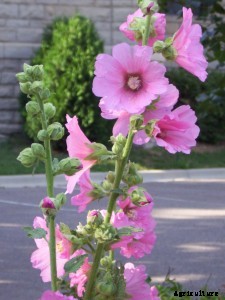
They derive their name from the Old English holi (holy) and hokke (mallow). Another early name for the plant is “St. Cuthbert’s cole.”
The leaves were formerly used as potherbs or in salads, best collected in the cool of early winter.
Most hollyhocks are classified as biennials, but a few perennial varieties and even a couple of annual varieties. The perennials are short-lived, Hoewel, often only living 2 to 3 seasons. They self-seed readily and will reappear in the garden even years after removing the mother plants.
Sow seeds of hollyhocks in mid to late summer. The plants will return in spring and bloom the following summer. They like full sun and moist, rijk, goed doorlatende grond. Barely cover the seeds and keep them moist until they germinate. Cover the small plants before consistent freezing weather sets in.
Hollyhocks are susceptible to rust, and indeed it is the most often heard complaint about them. Removing the two lowest leaves shortly after they appear sometimes helps keep the rust from attacking them. You may be able to contain the rust to the lower leaves even if it does appear. Another option is to plant shorter flowers near them to hide the rust-infected lower leaves.
Water from below and provide plants with a lot of space in which to grow and breathe. Treat plants with fungicide if you cannot tolerate looking at the rust. These measures will sometimes keep rust from attacking. If it does appear, remove the affected leaves and put them in the trash. Do not add to the compost pile.
Hollyhocks are sometimes found growing on abandoned farms or along roadsides. They also make good additions to cottage-style gardens. They grow to heights ranging from one foot up to nine feet. The taller ones work great in the back of the flower garden, and the shorter varieties can be tucked in wherever the look of their spikes is desired.
Sunflowers are native to the Americas and have been cultivated for over 4, 000 jaar. They were a major food source for the indigenous population and were even used medicinally.
Botanically called Helianthus from the Greek helios, meaning sun, and Anthus, meaning flower, sunflowers were adopted as a major crop by the Russians. Sunflower oil stays liquid at lower temperatures than animal fats, which was advantageous in their cold climate.
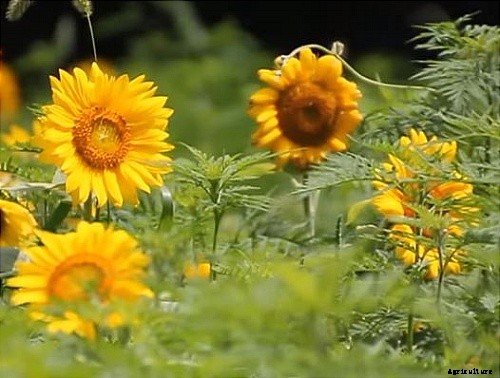
Victorians fell madly for sunflowers and used their likeness in art and architecture. Early American pioneers pounded the stalks to extract the fibers. The stalks were also used as kindling, and the seedless hulls were compressed into fire logs.
Plant sunflowers in mid-spring about 1 to 2 weeks before the date of your average last frost. They need full sun and aren’t overly fussy about soil fertility, although they benefit from a side dressing of compost.
Thin the seedlings, so the plants stand 12 to 18 inches apart, depending on the size of the variety at maturity. Many varieties will first produce a large basal flower and then branch out to produce many smaller blooms after the basal flower is cut. Some varieties naturally branch out, producing many smaller flowers.
Hybridizers have been busy, and sunflowers now come in various sizes and many colors in the yellow/gold/orange/rust family. They are spectacularly planted in various heights and colors as a theme garden.
Sunflowers reseed themselves prolifically and will come up every year, even if you don’t want them to. It goes without saying that small wildlife, such as birds and squirrels find them irresistible.
If you want to harvest the seeds for snacks or for planting next year, cover the flowers with a paper lunch bag when the seeds begin to ripen. Anders, the local livestock will completely devour your sunflower crop.
The blooms of sunflowers turn to follow the sun’s path, beginning in the east in the morning and continuing throughout the day. They are one of the few flowers that follow this peculiar practice.
By all means, cut them and use them in bouquets. Their bright, cheery colors look good in any decor.
Fresh summertime sweet peppers are plentiful at supermarkets and farmer’s markets everywhere. Their bright colors beckon you to look, smell, and buy them.
Sweet peppers are known scientifically as Capsicum annum and are members of the nightshade family. They are usually plump and bell-shaped, featuring either 3 or 4 lobes, although other sweet peppers are more tapered and have no lobes.
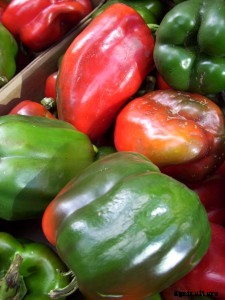
The four different types of sweet peppers are bell, banana, cubanelle, and pimento. Like their hot relatives, they also originated in the Americas. The word “chile” is from an Aztec word, “nahuatl, ” although aboriginal South Americans called it “aji.” Archeological evidence shows that Peruvians have been eating wild peppers since about 7000 BC and have cultivated them since approximately 6100 BC.
Start sweet peppers from seed indoors about 6 to 8 weeks before the average date of your last spring frost—Harden off before transplanting to the garden, which should be done when you transplant your tomatoes. Sweet peppers will not grow well in cold, wet soil and do not grow when nighttime temperatures dip below 50°.
Space pepper plants 18 to 24 inches apart in rows 24 to 36 inches apart. For intensive spacing, plant 14 to 18 inches apart in all directions. Side dress with granulated fertilizer when planting and add a scoop of compost to the planting hole. Peppers thrive in well-drained fertile soil and need consistent moisture. Apply liquid fertilizer after the first round of infant peppers have set and continue to fertilize weekly throughout the growing season.
All peppers need consistent moisture to set fruit. Lack of this or drought can cause blossoms or even infant fruits to drop off the plant. Hot, dry winds and soil can prevent the fruit from forming in the first place.
If you are a smoker, wash your hands before handling pepper plants. It is possible to transmit the tobacco mosaic disease (if present in your cigarette tobacco) to your garden sweet peppers, as they are both members of the nightshade family.
Stuffed peppers are one of the most popular ways to serve summer’s bounty of fresh sweet peppers. Most cultures have their own recipes, but all usually feature a filling of rice and some type of meat or protein, along with their favorite herbs and spices. Many other recipes use peppers in many creative ways. Their use as an integral component in recipes has become almost as commonplace as onions and garlic.
Within 50 years of being brought back to Spain, sweet (and hot) peppers spread throughout Europe and the Mediterranean region. Soon after that, Portuguese explorers had successfully introduced peppers to Africa, Indië, Southeast Asia, China, and Japan.
Sweet peppers are one of the most widely used vegetables/seasonings in the world.
Swiss chard is a green that grows well during the hot summer months, usually without turning bitter. Any bitterness will only be in the mature outer leaves and disappears when they are cooked. When sweltering summer weather passes, the large outer leaves will lose their bitterness, and they’ll begin to grow sweet and succulent again.
Thought to originate in Sicily, the original varieties of Swiss chard had white stems. Nog altijd, new varieties have been developed in recent years with stems of bright colors, such as the rainbow Swiss chard in the photo at right. Even the leaves can have a slight purple tinge.
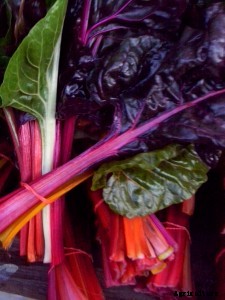
Swiss chard was originally called “Swiss” because seed catalogs in the 19th century wanted to distinguish it from French spinach. Botanically it is called Beta vulgaris flavescens and is a member of the same family as beets. Essentially it’s a beet without a root.
Plant Swiss chard, rainbow or otherwise, in mid to late spring. Plant seeds 1/4 inch deep and an inch apart in rows 12 to 18 inches apart. When the young plants are about three inches high, thin to stand about 4 to 6 inches apart, plant them 6 to 8 inches apart in all directions for intensive spacing. It’s not overly fussy about the fertility of the soil.
If you’re a lazy gardener (like me), Swiss chard will be a good friend to your garden. It withstands neglect and will even grow during droughts.
You can start harvesting leaves of any size. You can add tender young leaves to salads or stir-fries. You should cut larger, more mature leaves from the outside of the plant, and the new leaves at the center of the plant should be left to mature.
Swiss chard will even grow in partial shade and still produce a respectable crop. It survives temperatures down into the ’20s. Even if the leaves outside the plant freeze, the inner leaves will still be intact and edible.
The entire plant is edible, but the stems need a longer cooking time than the leaves. interessant, American cooks primarily use the leaves, and European cooks primarily use the stems. I use the entire plant.
The stems have the texture of cooked celery and should, in feite, be cooked similarly. The leaves can be substituted in virtually any recipe calling for spinach, with a slightly longer cooking time.
Late summer is the time to start planting for fall harvests. Now is the time to plant vegetables that prefer to mature during cool weather.
Plant Pisum sativum—the English garden type along with edible-podded snow and snap varieties—in early to mid-August for harvesting in mid to late September.
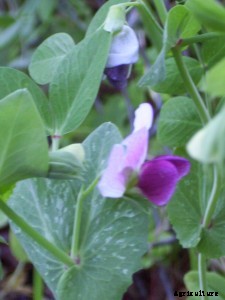
Plant peas in between the rows of corn in your garden. The corn will mature and be harvested long before the peas need the room. Another good place to plant fall peas is where lettuce or other greens were growing. These leafy crops deplete supplies of available nitrogen in the soil, and the roots of peas “fix” nitrogen into the soil.
This is a complicated scientific process that I’m not qualified to explain. Suffice it to say that it works. Once the plants are finished producing, leave their roots in the ground, and they will release the captured nitrogen into the soil, where it can be used by other plants that you subsequently grow in the same area.
When planting peas for fall, plant them almost twice as deep as spring-planted peas. This will help keep the seeds cool and also from drying out before they germinate. In any case, keep them well-watered to avoid overstressing them and also mulch the soil to keep it cool.
Space the seeds about two inches apart and thin the seedlings to about four inches apart when they’re three inches high.
Snap peas and Oriental snow peas grow tall enough to require some support for them to climb upon. English garden peas only grow about 12 to 18 inches high and do not need such support.
The blossoms and new growth shoots of pea vines are also edible. In feite, the seedlings that you thin are completely edible. Simply pinch off the roots and toss them into a salad or stir-fry.
Check your pea vines daily once they start producing. Edible podded peas are best eaten when the peas inside are just starting to swell. English garden peas, traditionally eaten when plump and succulent, can quickly become tough and woody if left too long on the vines.
When freezing weather kills off the vines, leave the roots in the soil. By spring, they will be nearly completely decomposed and ready to plant a crop that likes rich, well-fertilized soil, zoals tomaten, komkommers, or melons.
Dusty Miller has grown annually in much of the temperate zones, but it’s technically a perennial. In Zone 7 and warmer, it will survive winters and is often planted with pansies in winter flower gardens.
You can find Dusty Miller available in several cultivars under the Latin name Senecio cineraria. The first name, Senecio, comes from the Latin “senex, ” which means old man. The second name, cineraria, means ashy gray in Latin.
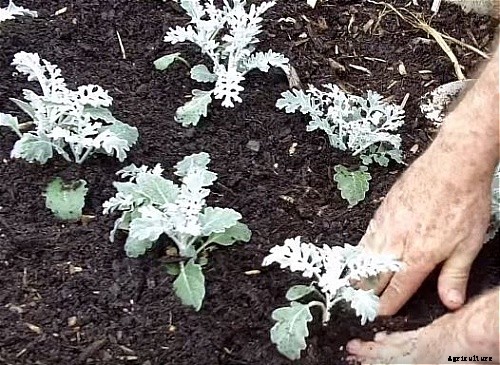
A more finely leafed variety is excellent to use in hanging baskets or any container. The lacy foliage really stands out when viewed up close.
Plant them in among your flowers for a shimmering backdrop to their bright colors. Dusty Miller prefers full sun to part shade so that you can plant them among virtually all blooming plants.
Native to the Mediterranean, Dusty Miller prefers sandy, goed doorlatende grond. This is one member of the flower border that can withstand drought. It is excellent planted in window boxes that are beneath the eaves of your house and therefore do not receive much natural rainfall.
It isn’t bothered by many pests except the occasional aphid, which can be washed off with a strong spray from the hose. Do this on a cloudy day, so the fuzz on the leaves doesn’t get burned by the sun.
You can start them from seed indoors about eight weeks before your last spring frost, but they’re also widely available in spring as bedding plants. Space them 8 to 10 inches apart, and they will quickly grow to cover the area.
Their lacy, shimmery, gray foliage makes ideal plants to add to a white garden. Planted near patios or terraces, their soft gray color reflects nighttime exterior lights for a magical effect after dark.
Zinnias are native to the American Southwest and Mexico. They are members of the Asteraceae family. Its cultivars number in the hundreds since breeding and hybridizing begin in the 19th century.
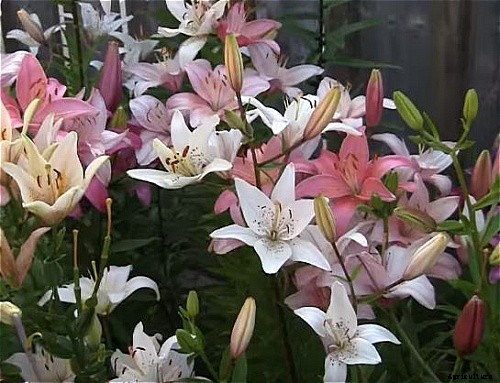
The more familiar species is Zinnia elegans, which includes most Zinnia cultivars, including double-flowered types that grow from one to three feet high. Zinnia linearis grows into a smaller, bushier plant and usually has single flowers. It is also more resistant to powdery mildew than Z. elegans. Hybrids between the two species show this resistance on plants that have traits of both parents.
Zinnias are one of the most popular seeds planted in school gardening projects. The seeds are large enough for little fingers to handle easily, and they germinate and grow quickly, blooming within a couple of months of sowing.
You can get a jump on the season by starting zinnias indoors under lights about 4 to 6 weeks before the average date of your last spring frost. Harden off plants gradually and transplant them into the garden. Ten slotte, the danger of frost is past when you plant your tomatoes outdoors.
Zinnias like full sun and soil rich in organic matter but loose and friable with good drainage. Their native home is in sandy soil, and they will not grow in heavy clay soils.
The scourge of zinnias is powdery mildew. All varieties can show signs of the disease, with those in the variety Zinnia linearis a little less susceptible. Space the plants the maximum distance recommended for the type you are growing. Don’t water afternoon as this lessens the chance of the foliage being wet after sundown. Zo mogelijk, don’t water with an overhead sprinkler.
Remember to deadhead your zinnias by removing faded flowers, and they will continue to bloom until killed by frost. They are often one of the last flowers whose blooms still look good when other annuals have faded.
Zinnias make wonderful cut flowers. They last for a long time, and their wide range of colors makes them compatible with most other flower varieties.
The small varieties looked charming cut with short stems and placed in tiny vases or antique china teacups. Set them in unexpected places throughout the house.
Hydrangeas are those large, bush-type perennials with giant flower heads in either white, roze, or blue. They’re also called “mophead” or “lacecap.”
Fossil records show that hydrangeas grew in North America between 40 and 70 million years ago and about 25 million years ago in Asia.
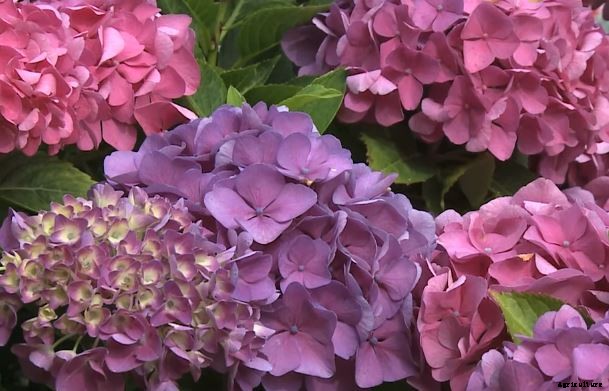
They bloom in mid to late summer and keep their flowers long after their leaves drop off in fall. The flowers looked spectacular on the plants for winter interest in the garden or cut and dried for indoor flower arrangements.
Plant hydrangeas in full sun to partial shade in moist, rijk, loamy soil that is well-drained. Add generous amounts of compost when transplanting and top dress with compost every spring.
The name “hydrangea” comes from the Greek words hydro (water) and angeion (vase) or “water vase.” The name doesn’t refer to the flowers; it refers to the shape of the seed capsule.
Hydrangeas are unusual in that you can change the color of their flowers by changing the pH of the soil in which they grow.
To make hydrangeas flowers pink like the ones in the photo above, raise the pH of their soil. Do this by adding dolomitic lime to the soil several times a year (available at garden supply stores). Follow the manufacturer’s instructions for correct quantities and add that amount to the soil around each plant in spring, zomer, en val.
Another thing to do to keep your hydrangeas blooming pink is to use a high phosphorus fertilizer (the second number on the fertilizer label—for example, 10-15-10).
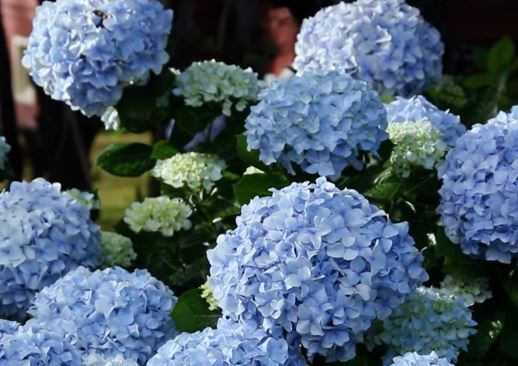
If blue hydrangeas are what you are after, add aluminum sulfate (a soil additive available at garden supply stores) to the soil they are growing. Mix 1 tablespoon aluminum sulfate with one gallon of water and apply a half-gallon of this mixture to the soil around each plant.
Caution: water your hydrangeas well the day before you do this so the roots can more easily take up the aluminum sulfate without getting burnt. Apply the aluminum sulfate mixture to the soil in spring, zomer, en val.
To help keep your hydrangeas blooming blue, use a low phosphorus fertilizer (the second number on the fertilizer label) and high in potassium (the third number on the fertilizer label). Bijvoorbeeld, use a fertilizer labeled 25-5-30. Avoid using superphosphates or bone meal if trying for blue hydrangeas.
If your best efforts to turn hydrangeas either pink or blue result in them turning the opposite color, the culprit is most likely your water. Water with a high pH will tend to produce pink hydrangeas; conversely, water with a lower pH will produce blue hydrangeas—both despite soil amendments to the contrary.
Eindelijk, hydrangeas planted near a concrete foundation or walk will tend to bloom pink because of the considerable amount of lime leaching out of the concrete, which raises the pH of the soil.
One last note on changing the color of hydrangeas:white hydrangeas will always be white and cannot be changed to pink or blue.
Read also:Flowers and Plants for Northern Gardens
Lilies come in several different varieties with blooming times from midsummer through early fall. Plant some of each variety for a continuous supply of blooms throughout the growing season.

Although you can plant lily bulbs in spring, fall is the best time for planting as it gives them time to develop a strong root system before breaking into vegetative growth the following spring. Potted lilies in active growth can be planted in your garden at any time during the growing season.
Lilies are grown from bulbs with fleshy overlapping scales with no protective covering. Plant them soon after purchasing and don’t allow them to dry out.
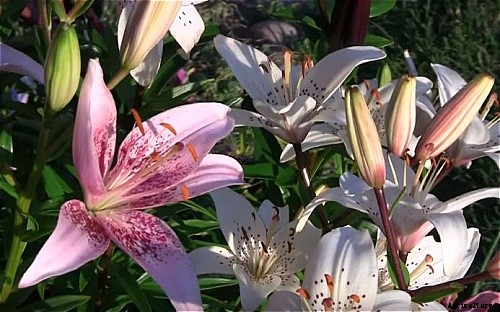
Plant them in well-drained soil in a site where water does not stand after rainfall. Dig down 12 inches and remove rocks. Add peat moss and compost to improve the soil and help with drainage. According to the manufacturer’s recommended quantities, add a little bone meal to the bottom of the hole and scratch it in with your garden claw.
A pleasing way to display lilies in the perennial garden is to plant them in groups of three or five bulbs, spacing the individual bulbs 8 to 12 inches apart. Space the groupings 3 to 5 feet apart. Small bulbs should be planted 2 to 4 inches deep and larger ones 4 to 6 inches deep, as measured from the top of the bulb up to the surface.
Spread organic mulch-like cocoa hulls over the bed. Just before the ground freezes for the winter, add a layer of protective mulch of evergreen boughs, hooi, or fallen leaves.
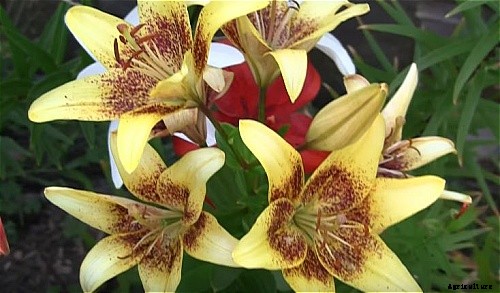
Asiatic lilies start the lily season when they bloom around midsummer. The picture above is of Asiatic lilies blooming right now in Zone 4. Most types of flowers face upward and have few markings on the petals—Hardy in Zones 4 to 9.
Trumpet lilies begin blooming at midsummer. They are named for their trumpet-shaped flowers and are hardy in Zones 5 to 9.
Tiger lilies bloom from midsummer on. They have freckled, pendulous blooms with petals that curve back on themselves. They multiply prolifically and will form large clumps in a few years. Each stem produces many flowers in warm colors, from golden yellow to orange, to red—Hardy in Zones 3 to 9.
Rubrum lilies bloom in late summer to early fall. They resemble Tiger lilies but come in cool colors from white to deep pink. Their blooms are sweetly fragrant—Hardy in Zones 4 to 9.
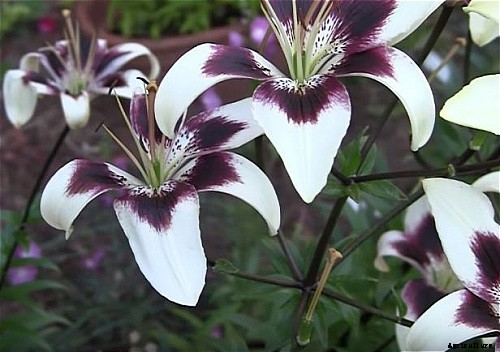
Oriental lilies start blooming in late July, with some varieties not coming into bloom until late August or September. They are intensely fragrant with flowers up to 10 inches across—Hardy in Zones 4 to 9.
Orienpet lilies are a cross between an Oriental and a Trumpet lily. They bloom from mid to late July into mid-August and can reach eight feet high. Flowers come in both warm and cool shades, with some varieties extremely fragrant. They prefer dappled sunlight or morning sun with afternoon shade—Hardy in Zones 4 to 9.
Plant a variety of lilies, so you have a continuous supply of blooms from midsummer through fall.
Honeysuckle vines, belonging to the Lonicera species, are easy to grow, heat-tolerant, vigorous, and nearly indestructible. They are commonly used to climb up a trellis, schutting, or another framework. Less well-known is their use as a ground cover for erosion control.
Said to protect your garden from evil, honeysuckle is known as the “love bind” because it symbolizes a lover’s embrace with its clinging growth habit.
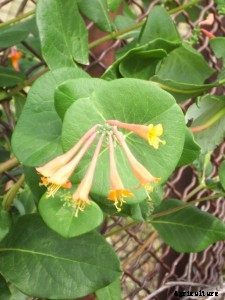
They prefer full sun but will tolerate partial shade. They are drought-resistant once established and only need supplemental fertilizer in early spring and again at midsummer.
Plant honeysuckle in early spring, when all danger of frost has passed. Prepare the planting area by adding peat moss and compost. Dig the soil to a depth of about 6 to 8 inches. Mulch well after planting. Honeysuckle like their leaves in the sun and their roots in the cool shade.
Prune for shape after they finish blooming but only prune lightly until the vines are in their third growing season.
Aphids love honeysuckle, and you’ll need to be vigilant in washing them off with a strong spray from your hose.
Notorious for its sweet scent, honeysuckle vines attract both bees and hummingbirds, who feast on the nectar deep within their elongated blossoms.
Honeysuckle will climb up anything with just a little help from you. Get the vines started climbing by loosely tying them to their supporting structure. They will soon grow and fill it in so much that the supporting structure will virtually disappear.
Folklore tells us that if you bring honeysuckle into your house, there will soon be a wedding. And if you sleep with a sprig of it under your pillow, you will dream sweet dreams.
Of your impending nuptials, no doubt.
Spring blooming lupines, Lupinus albus, were cultivated 4, 000 years ago by the Egyptians. In Amerika, Lupinus mutabilis were brought into cultivation 1, 500 years ago.
Although we think of lupines as flowers, they are grown as feed for livestock in many parts of the world. Because they grow well on poor, sandy soils and, in feite, improve the soil, lupines are often grown for soil improvement and followed by a more demanding crop, such as melon, maïs, or wheat.
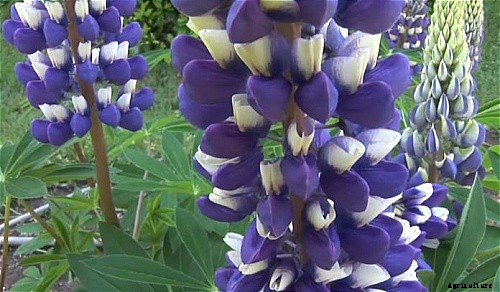
Romans used them medicinally for skin ailments and as an antidote for the bite of an asp, although there is no data on the latter’s effectiveness.
Lupines prefer slightly acidic soil that is well-drained and moderately fertile. They do best in full sun but will grow in partial shade.
Sow annual lupines from seed around the time of your last frost. They will bloom about two months later.
Perennial lupines are best sown from seed in autumn. Soak the seeds in warm water for a day before sowing. They will bloom in mid-spring. You can also start plants indoors about eight weeks before consistent frost-free weather in your area. Plant outside. After all danger of frost is past.
Space lupines about 10 to 12 inches apart. Water regularly and fertilize with a high phosphorous, low nitrogen fertilizer. (In other words, a low first and a high second number, such as a fertilizer labeled 5-25-10.)
Lupines come in blue, paars, roze, geel, and white. They will bloom over and over if you deadhead them by cutting off faded flowers.
Pliny, the Greek writer, and physician claim that the smoke of burnt lupines kills gnats.
I wonder if it works on mosquitoes.
Salvia is a popular flowering plant for urban gardens. With a combination of over 700 annual and perennial species, there’s a type of salvia out there for everyone.
They can prolifically reseed themselves, like the ones in the photo at left. These are growing in the cut-out area of a sidewalk around the installation of a telephone pole. They most likely blew in from the cultivated salvia growing in a flower bed a couple of houses down the street.
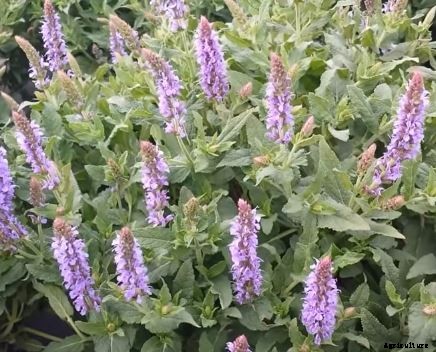
Although I don’t know the variety of this particular salvia, it is most likely one of the tender perennial varieties treated as annuals in temperate regions.
Salvia does best in full sun. Blijkbaar, they’re not fussy about their soil, only that it should be well-drained.
If you’re planting salvia, you can direct seed it right in the garden in late spring. Sprinkle the seeds on top of the soil. Do not cover; press them in gently with your hand. Mist lightly after you plant them and then mist daily to keep them moist until they germinate.
You can also propagate them by root division, which is best done in spring.
They’re also one of the most popular bedding plants found at garden centers and farmer’s markets every spring.
Space salvia 10 to 20 inches apart, depending on the size at maturity of the variety you’re planting.
Although the red variety of salvia is often planted, the purple variety provides a cool contrast to the hot reds, oranges, and yellows of most summer-blooming flowers. And it reseeds itself.
In Minneapolis today, workers hoisted the last steel beam to the top of the new baseball stadium.
Attached to the steel beam was a pine tree.
The tradition goes back some 1200 years to the Vikings (somehow appropriate). Scandinavian builders topped off their buildings with a sheaf of grain for the horse of their beloved god, Odin. For his part, Odin was so pleased with this that he bestowed good luck on the future occupants.
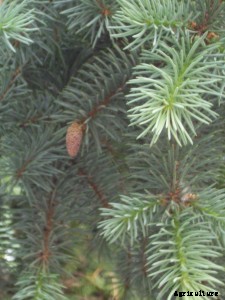
As the Vikings spread throughout (conquered) Europe, they brought their topping off practice with them. Britons and Germans substituted trees for the grain, and interestingly enough, the Scandinavians eventually switched to using a tree.
The tradition was brought to America by Scandinavian ironworkers, who promptly added an American flag. Eventueel, it became common for the workers to sign the beam before you set it in place.
Not only does raising a pine tree commemorate the building to the highest point of the structure, but it also celebrates doing so without serious injury to the workers.
Pine and evergreen have long symbolized hope to humanity. During the cold, donker, seemingly lifeless winter days, the pine and evergreen remain green and look alive.
Voor het grootste gedeelte, pine trees do not need pruning. If you do prune a pine, don’t remove whole branches; the tree may never recover. Bijvoorbeeld, if a branch is growing into a path, cut a few inches off the tip rather than the entire branch.
Evergreen shrubs and small trees are often pruned to maintain their size and shape in the landscape. June is the ideal time for this.
Opnieuw, prune sparingly. Only prune off the tips of the branches. If it is necessary to remove an entire branch, do not cut it off flush with the main trunk. Leave a quarter-inch stump.
If you have a large pine or evergreen which has overgrown its space and you’re tempted to cut off the bottom branches, do the tree and yourself a favor and have the tree removed.
Cutting off the lower branches of an evergreen removes the lowest level of support for snow-filled branches. Eventueel, starting at the bottom, the remaining branches will break under the weight of the snow.
Remove the tree and plant something that loves acid soil, like blueberries or rhododendrons.
Blueberries taste a lot better than pine cones anyway.
I captured a zucchini blossom this morning on a plant that’s barely bigger than a transplant. It’s actually the second one that opened. I missed the first flower—you can see it wilted in the background in the photo at left.
Zucchini, come on like gangbusters, and don’t let up until the weather cools in fall. Stories of grocery bags filled with zucchini that were left on neighbor’s doorsteps were circulating in the neighborhood a few years back, but no one came forward as the alleged recipient.
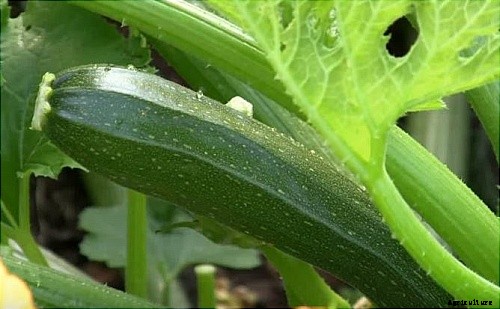
All squash are native to the Americas, but zucchini is a mutant or sport that originated in Italy. Its name comes from the Italian zucchino, which means “little squash.” Botanists called it Cucurbita pepo, a member of the same family as cucumbers and melons. In the United Kingdom and New Zealand, zucchini is referred to as “courgette, ” while Australians and Americans call it “zucchini.”
Whatever you call it, you have to call it versatile. You can serve zucchini cooked or raw, sweet or savory. Zucchini is grilled, fried, deep-fried, stuffed, or baked with an endless variety of spices and seasonings. And virtually everything you can do with the fruit of zucchini you can do with the blossom.
In feite, one of the ways you can “temper” the amount of zucchini your plants produce is to harvest the blossoms. Stuff them, dip them in tempura batter and deep fry them. Bake them. Put them raw into salads. Use them as a filling for quesadillas.
Sometimes you can find a perfect zucchini blossom still attached to the tiny zucchini fruit at its base. These are much sought after by gourmets and pricey restaurants.
You grow zucchini the same way you grow cucumbers. Plant them in late spring. Ten slotte, the danger of frost has passed. Plant five or six seeds in “hills” of soil. When the plants are about two inches high, thin to the strongest two or three plants, this is best used for “bush” varieties of zucchini, which form a compact bush-like plant.
For varieties of zucchini that grow into a vine, it’s best to grow them vertically. Zucchini will climb a vertical trellis or net with just a little help from you. Vertical growing keeps the plants off the ground and makes it easier to see the fruits.
Make sure to harvest zucchini every day. Pick fruits before they reach six inches in length when they are the most tender and flavorful. If you miss a few and get a little large, peel them, seed them, grate them, and make zucchini bread. Or add a couple of cups of grated zucchini to any chocolate cake recipe.
Read also:Flower Meaning Perseverance – Magnolia
But try to resist leaving them on your neighbor’s doorstep.
Read also:How To Rebloom Orchids

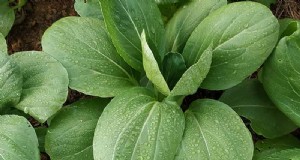
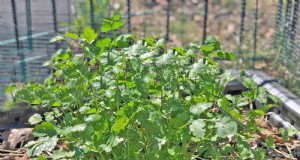
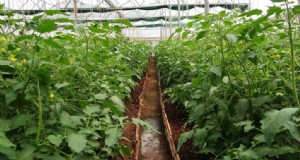

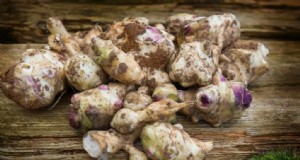
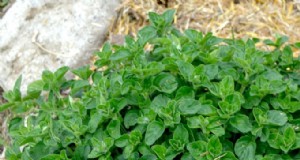
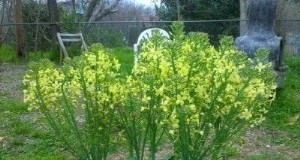
Broccoli vastschroeven:Broccoli kweken bij warm weer
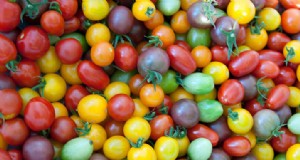
Soorten tomaten voor tuinglorie
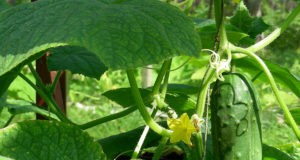
Komkommers kweken die niet bitter smaken?

De 'drie zussen' teruggeven - maïs, bonen en pompoen - naar Indiaanse boerderijen voedt mensen, land en culturen
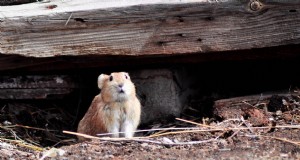
Hoe u muizen uit de buurt van uw auto en andere voertuigen kunt houden?

Groenten eten voor B-vitamines:groenten met een hoog vitamine B-gehalte
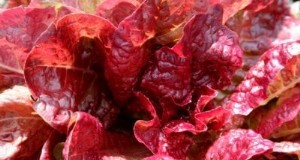
Wat is Joegoslavische rode sla - Zorgen voor Joegoslavische rode slaplanten?
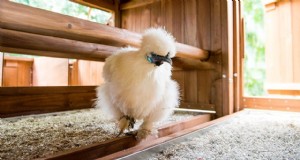
Een eenvoudige gids voor verschillende soorten beddengoed voor dieren
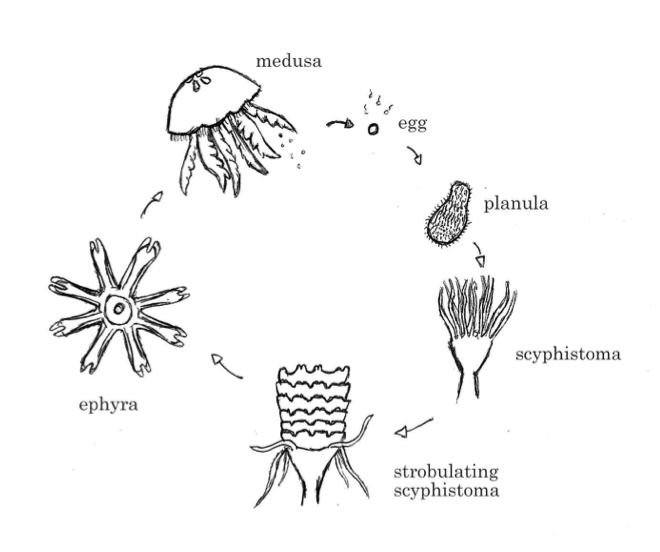
kwallen; aquacultuur vriend of vijand Meer dan alleen een bloeiplaag?
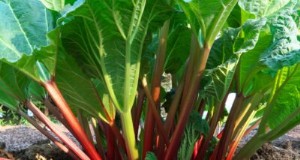
Rabarberplanten verdelen:hoe en wanneer rabarber verdelen?